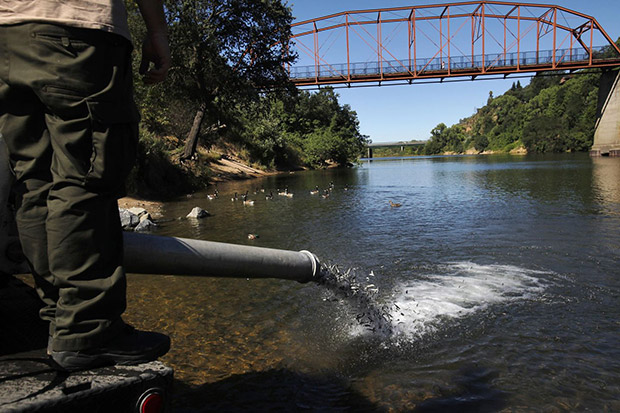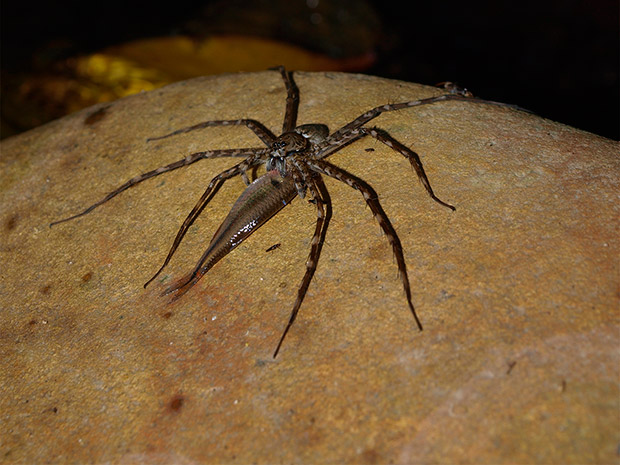
On Wednesday, state Department of Fish and Wildlife workers netted the last of the 430,000 steelhead trout fingerlings from the Nimbus Fish Hatchery, trucked them to a boat launch about five minutes away and released them into the American River.
Nobody knows whether the 3-inch-long fish will survive, but they’re expected to have a better chance than they would have had if they had been left in the hatchery tanks, which are filled with reservoir water piped in from the Folsom Dam.
The problem is that, due to the California drought, the Folsom reservoir is only 52 percent of capacity and the sizzling Central Valley temperatures are expected to heat the water to 78 degrees by August, a temperature that would have meant certain death for the young fish.
“That’s too hot for steelhead. We expect they will have a better chance in the river” where they might be able to find cold pools of water, said Gary Novak, the Nimbus Hatchery manager. “The situation is pretty severe. I have to get rid of all my fish and then hope it rains next year.”
The Nimbus Hatchery is one of 22 breeding facilities run by the state that supply most of the salmonids left in the ocean along the Central Coast. These hatcheries raise 30 million to 40 million fish annually and plant them in rivers and streams. The state’s hatcheries were established decades ago primarily as mitigation for dam building, and experts say there would hardly be any salmonids at all swimming in the rivers if not for the breeding program.
From tanks to trucks
The 85,000 silvery fish that were released Wednesday were held in rows of long green tanks in a warehouse. Reservoir water flowed into each tank through a spigot on one side and many of the index-finger-size fish leaped up into the spraying water as workers with nets scooped them up by the hundreds. The squiggling trout were brought in buckets to a tanker truck, which then dumped them through a pipe into the river, where a couple of waiting ducks feasted.
The Nimbus Hatchery harvests eggs and sperm from the salmon and steelhead that swim back to the hatchery starting in September. The fish are identifiable because hatchery workers remove their adipose fins, which are next to the dorsal fin. The fish that were released early also had ventral fins removed so that fisheries biologists can determine how many of them return in three to five years.
Nimbus released all 3.6 million of its chinook salmon three weeks ago so it is now empty, leaving its two managers and six employees with little to do except maintain equipment until next year. All the fish have also been released at the nearby American River Trout Hatchery, which raises rainbow trout for recreational fishing in lakes.
“This (hatchery’s problem) happens to be the tip of the iceberg,” Novak said. “We have the warmest water, (but) with this drought I would assume there is concern at every hatchery.”
Experts, however, said they believe the rest of the hatcheries in California, including the federally managed Coleman Hatchery, will make it through the summer months and into the winter season without having to evacuate fish. But nothing is guaranteed, given that this summer is expected to be one of the hottest on record.
In addition to concerns about warming water, low reservoir levels have left many boat ramps that are used to plant fish high and dry. The state Fish and Wildlife Department bypassed the rivers and planted millions of chinook salmon directly into San Francisco Bay this year because of low stream flows and warming water. That included more than 3 million salmon from Nimbus that normally would have gone into the American River. That could be problematic because steelhead and chinook imprint on the rivers in which they are born and have a higher rate of return when they swim to the ocean themselves.
Usually freed in February
The 4-month-old fish from Nimbus – which officials hope will make up the vast majority of the steelhead that spawn in the river when they return in three to five years – would have been released in February under normal conditions. This week marked the earliest time the hatchery has ever released its steelhead, which must now run a gauntlet of predators, low water flows and hot temperatures in the river before they are ready to swim out to the ocean next winter.



